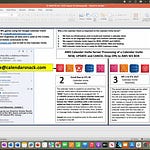1. What is the core technology demonstrated in the "AWS MLB Calendar Invite Server Demo"?
The core technology demonstrated is the AWS Calendar Invite Server, a proprietary stack of nine APIs built on an AWS account. This server powers an application called "Calendar Snack," which is used to generate and manage calendar invitations, particularly for large-scale event schedules, such as the MLB season.
2. How does the system handle and display a large volume of events, such as the MLB schedule?
The system is designed to handle a massive volume of events, exemplified by the MLB's 2400 games. It displays these events in a "schedule engine" as a visual calendar. For end-users, it focuses on "upcoming" games, filtering out past events. The data for these events is stored in an S3 bucket and processed through a proprietary ETL (Extract, Transform, Load) system to assemble calendar invites on the fly, ensuring efficient and real-time display.
3. How does a user interact with the schedule engine to receive calendar invites?
A user, such as "Zach" in the demo, provides an email address to the scheduling engine. The system then presents a visual calendar of upcoming games. With a single click on a specific game's button, a calendar invite for that event is immediately sent to the provided email address. This streamlined "one-click" functionality makes it easy for users to add events to their personal calendars.
4. What kind of information is contained within the calendar invites sent by the system?
The calendar invites sent are standard invites that appear in a user's email inbox. While the specific details shown in the demo are limited to the game and date (e.g., "Braves versus Chicago on August 18th"), the system's ability to track RSVP status suggests that these invites contain the necessary information for a calendar application to recognize them as events, including the ability to accept, decline, or mark as "maybe."
5. How does the system track and manage the status of calendar invite RSVPs?
The AWS Calendar Invite Server actively collects and monitors calendar receipt data. When a user responds to an invite (e.g., by accepting or marking as "maybe"), this RSVP status is captured and updated in the system's backend. The demo shows how an initial "accepted" status can be changed to "maybe," with the system immediately reflecting this update in its reporting engine.
6. What are the potential uses for the collected calendar receipt data?
The collected calendar receipt data (such as RSVP status) has several potential uses. The demo briefly mentions that this URL can be shared and shortened for "promotions." Furthermore, the system enables the updating of this data for a "large consumer base," allowing businesses to leverage this information for marketing campaigns, understanding audience engagement, and potentially for re-engagement or follow-up communications related to the events.
7. What is the role of the "render engine" in this system?
The "render engine" appears to be the interface or mechanism through which the collected calendar data and RSVP statuses are visualized and reported. The demo shows the presenter navigating to the "render engine for the reporting" to view the number of accepted invites for a specific game on a particular date, indicating it serves as a central hub for administrators to monitor event engagement.
8. What is "Calendar Snack" and its relationship to the AWS Calendar Invite Server?
"Calendar Snack" is an application built to serve as a demo engine for the AWS Calendar Invite Server. It acts as the user-facing interface that interacts with the nine APIs of the AWS Calendar Invite Server stack. Essentially, Calendar Snack is the practical demonstration of how the underlying AWS-powered invite server functions, allowing for the visualization and interaction with the calendar invite generation and tracking process.
Analog Vid
AI Vid
AWS Calendar Invite Server Demo Study Guide
AWS MLB Calendar Invite Server Demo Study Guide
I. Quiz
Instructions: Answer each question in 2-3 sentences, demonstrating your understanding of the source material.
1. What is the primary purpose of the AWS Calendar Invite Server, and what large-scale event schedule is used as a demonstration?
2. Describe the core technological "stack" that powers the AWS Calendar Invite Server, mentioning its key components.
3. How does "Calendar Snack" function within the overall architecture, and what is its relationship to the AWS Calendar Invite Server APIs?
4. Explain the concept of an "upcoming landing page" in the context of the MLB schedule. What specific challenge does it address for users like "Zach"?
5. What proprietary technology is used to assemble calendar invites "on the fly" for users, and where is the raw data stored?
6. How does a user, such as "Zach," interact with the visual calendar to receive game invites? Describe the "one-click" functionality.
7. Beyond simply sending invites, what critical data does the system collect and track regarding the calendar invitations?
8. How does the system demonstrate the ability to update the status of an RSVP, for example, from "accepted" to "maybe"?
9. What is the significance of the "render engine" mentioned in the demo? What capabilities does it offer beyond simply displaying the schedule?
10. What is the approximate number of MLB games in a full season, and what portion of these games were being displayed in the demo?
--------------------------------------------------------------------------------
II. Answer Key
1. The primary purpose of the AWS Calendar Invite Server is to manage and send out calendar invitations at a large scale. It is demonstrated using the MLB game schedule, which consists of approximately 2400 games.
2. The core technological stack runs on an AWS account and consists of the AWS Calendar Invite Server itself. It utilizes nine APIs that interact with an API Gateway, which then communicates with a custom-built application called Calendar Snack.
3. Calendar Snack is the app built by the presenter that serves as a demo engine. It communicates with the APIs on the AWS Calendar Invite Server to populate and display data, effectively serving as the front-end interface for users to interact with the system.
4. An upcoming landing page displays the MLB schedule in a visually interactive calendar format, explicitly focusing on future games. It addresses the challenge of presenting 2400 games by only showing relevant, upcoming events to a user like Zach, rather than past games they cannot attend.
5. The raw data for the MLB games is stored in an S3 bucket. A proprietary ETL (Extract, Transform, Load) process then takes this data and assembles the calendar invites on the fly as users interact with the schedule.
6. A user like Zach inputs their email address into the visual calendar. The schedule then pre-populates with "one-click" calendar invite buttons next to each game. Clicking these buttons instantly sends a calendar invite for that specific game to the provided email address.
7. The system collects and tracks calendar receipt data, specifically monitoring the status of RSVPs. This includes whether an invite has been accepted, declined, or changed to a "maybe" status by the recipient.
8. The system demonstrates updating RSVP status by having "Zach" change his response to an invite from "yes" (accepted) to "maybe." The backend then collects this updated data from the calendar receipt, reflecting the new status in the system's reporting.
9. The render engine is where the schedule is displayed and can be shared via a URL. It allows for shortening the URL and is useful for promotions. Crucially, it's also where the system collects and updates the calendar receipt data for a large consumer base.
10. A full MLB season consists of approximately 2400 games. In the demo, the presenter displayed 1,200 calendar events, representing about halfway through the season.
--------------------------------------------------------------------------------
III. Essay Questions
1. Analyze the scalability of the AWS Calendar Invite Server solution as described in the demo. Discuss how its architectural components (AWS account, APIs, API Gateway, S3, ETL) contribute to handling a large volume of events like the MLB schedule, and what challenges might arise with even larger datasets.
2. Evaluate the user experience demonstrated for someone like "Zach" interacting with the MLB schedule. What are the key features that enhance usability, and what potential improvements or additional functionalities could further streamline the process of receiving and managing invites?
3. Beyond simply sending calendar invites, the system tracks "calendar receipt data." Discuss the business value and potential applications of collecting and monitoring RSVP statuses (accepted, maybe, declined) for events at scale, as presented in the demo.
4. The demo highlights proprietary technology for assembling calendar invites on the fly. Explain the importance of this "on-the-fly" assembly and the role of the ETL process in customizing the user experience. How does this differentiate the system from a static calendar display?
5. Consider the "AWS Calendar Invite Server" as a generic service. Brainstorm and describe three distinct, real-world use cases (other than sports schedules) where such a system for large-scale, dynamic calendar invite management would be highly beneficial, explaining why for each.
--------------------------------------------------------------------------------
IV. Glossary of Key Terms
• AWS Calendar Invite Server: The core technology stack and application built on an AWS account designed to manage and send out large volumes of calendar invitations.
• Stack: In this context, refers to the integrated set of technologies (APIs, API Gateway, Calendar Snack app) that collectively form the AWS Calendar Invite Server system.
• APIs (Application Programming Interfaces): A set of defined rules and protocols that allow different software applications to communicate with each other. The system uses nine APIs.
• API Gateway: An AWS service that acts as a "front door" for applications to access data, business logic, or functionality from backend services, such as the APIs built for the calendar server.
• Calendar Snack: The custom-built application used as a demo engine. It interacts with the AWS Calendar Invite Server APIs to display schedules and send invites.
• Upcoming Landing Page: A specific view within Calendar Snack designed to display future events (e.g., MLB games) in a visual calendar format, filtering out past events.
• MLB (Major League Baseball): The professional baseball league used as the large-scale example for demonstrating the calendar invite server, featuring 2400 games per season.
• S3 Bucket (Amazon Simple Storage Service Bucket): A storage resource in AWS where data, such as the raw MLB game schedule, is stored.
• ETL Process (Extract, Transform, Load): A proprietary technology process that extracts data (from S3), transforms it (to assemble calendar invites), and loads it for display or sending "on the fly."
• One-Click Calendar Invite Buttons: Interactive elements on the upcoming landing page that, when clicked, automatically send a calendar invitation for the associated event to a specified email address.
• Calendar Receipt Data: Information collected by the system regarding the status of sent calendar invites, specifically tracking RSVP responses such as "accepted," "maybe," or "declined."
• Render Engine: The part of the system responsible for displaying the visual schedule and managing functionalities like sharing URLs, promotions, and collecting calendar receipt data.








